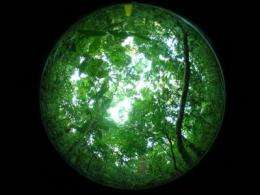First rainforests arose when plants solved plumbing problem

A team of scientists, including several from the Smithsonian Institution, discovered that leaves of flowering plants in the world's first rainforests had more veins per unit area than leaves ever had before. They suggest that this increased the amount of water available to the leaves, making it possible for plants to capture more carbon and grow larger. A better plumbing system may also have radically altered water and carbon movement through forests, driving environmental change.
"It's fascinating that a simple leaf feature such as vein density allows one to study plant performance in the past," said Klaus Winter, staff scientist at the Smithsonian Tropical Research Institute in Panama, who was not an author, "Of course, you can't directly measure water flow through fossil leaves. When plants fix carbon, they lose water to the atmosphere. So to become highly productive, as many modern flowering plants are, requires that plants have a highly elaborate plumbing system."
A walk through a tropical forest more than 100 million years ago would have been different than a walk through a modern rainforest. Dinosaurs were shaded by flowerless plants like cycads and ferns. Fast-forward 40 million years. The dinosaurs have disappeared and the first modern rainforests have appeared: a realm of giant trees—with flowers. By examining images of more than 300 hundred kinds of fossil leaves, the team, led by Taylor Feild from the University of Tennessee, Knoxville, counted how many veins there were in a given area of leaf. Flowerless plants then and now have relatively few veins. But their work shows that even after flowering plants evolved, it took some time before they developed the efficient plumbing systems that would allow them to develop into giant life-forms like tropical trees. The density of veins in the leaves of flowering plants increased at least two different times as the transition from ancient to modern rainforests took place, according to this research reported in the journal, Proceedings of the National Academy of Sciences.
The first jump—when the vein density in fossil leaves of flowering plants first exceeded vein density in the leaves of flowerless plants—took place approximately one hundred million years ago. The second and more significant increase in vein density took place 35 million years later. Petrified tree trunks more than a meter in diameter were first found from this period, indicating another landmark—the evolution of flowering trees. Soon the leaves of flowering plants had twice more veins per unit leaf area than the non-flowering plants. By the end of the Cretaceous period about 65 million years ago, the number of leaf veins per unit area was very similar to that of modern rainforest leaves.
As often happens, this study has seeded new questions. Did improvements in the plumbing system of flowering plants make giant rainforest trees possible? How important was this change in the plants to climate changes that were taking place at the time? Were these plants better able to take advantage of naturally occurring wet environments that were created by tectonic activity or changes in ocean circulation patterns, or did the trees themselves contribute to climate change by pumping more water into the atmosphere?
More information: Taylor S. Feild, Timothy J. Brodribb, Ari Iglesias, David S. Chatelet, Andres Baresch, Gary Upchurch, Bernard Gomez, Barbara Mohr, Clement Coiffard, Jiri Kvacek and Carlos Jaramillo. 2011. Fossil evidence for Cretaceous escalation in angiosperm leaf vein evolution. PNAS. Early online edition. doi: 10.1073/pnas.1014456108
Abstract
The flowering plants that dominate modern vegetation possess leaf gas exchange potentials that far exceed those of all other living or extinct plants. The great divide in maximal ability to exchange CO2 for water between leaves of nonangiosperms and angiosperms forms the mechanistic foundation for speculation about how angiosperms drove sweeping ecological and biogeochemical change during the Cretaceous. However, there is no empirical evidence that angiosperms evolved highly photosynthetically active leaves during the Cretaceous. Using vein density (DV) measurements of fossil angiosperm leaves, we show that the leaf hydraulic capacities of angiosperms escalated several-fold during the Cretaceous. During the first 30 million years of angiosperm leaf evolution, angiosperm leaves exhibited uniformly low vein DV that overlapped the DV range of dominant Early Cretaceous ferns and gymnosperms. Fossil angiosperm vein densities reveal a subsequent biphasic increase in DV. During the first mid-Cretaceous surge, angiosperm DV first surpassed the upper bound of DV limits for nonangiosperms. However, the upper limits of DV typical of modern megathermal rainforest trees first appear during a second wave of increased DV during the Cretaceous-Tertiary transition. Thus, our findings provide fossil evidence for the hypothesis that significant ecosystem change brought about by angiosperms lagged behind the Early Cretaceous taxonomic diversification of angiosperms.
Provided by Smithsonian Tropical Research Institute


















